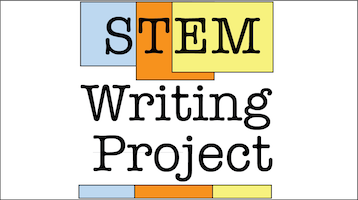STEM Writing Project
Undergrad Training
 Undergraduate Training Activities
Undergraduate Training Activities
Check back regularly for new training activities. Entries include source and date added. Many of these activities serve both training and diagnostic functions. These activities are marked "D&T". How diagnostic data are used is described further here.
Reading and Responding to Published Articles
(Source: STEM Writing Project. Added 5/17/22)
Undergraduates need to see examples of good scientific writing before they can replicate it themselves. Few of our students have read primary scientific literature before joining their first biology course, so their first writing-related assignment is to read and comment on a simple primary literature article.
We use Hypothes.is to manage this and other collaborative annotation assignments. Typically we choose an article from an undergraduate research journal, so it is not too difficult for students to read and analyze. As students' skills improve, we pose increasingly more challenging annotation questions.
| Resources | Links |
| Example of an article tagged for student annotation | PDF file |
| Supplemental description of the tagged article | DOCX file |
| SWP Quick-Guide to Hypothes.is for Students | DOCX file |
| SWP Quick-Guide to Hypothes.is for Teachers | DOCX file |
| Hypothes.is' Student Resource Guide | Link to web site |
| Hypothes.is' Instructor Resource Guide | Link to web site |
Learning Writing Vocabulary by Annotating Text Excerpts (D&T)
(Source: STEM Writing Project. Added 5/17/22)
To discuss scientific writing, novices must know the basic vocabulary we use to describe it. Students complete this text annotation activity in the first weeks of their first biology lab course. Students must demonstrate that they understand basic writing terminology by annotating text samples from scientific and lay articles. Patterns of annotations and follow-up quiz questions provide diagnostic information that instructors can use to decide which topics need reinforcement.
We developed both paper-based and web-based versions of this activity. The web version generates a detailed summary report of how students responded, but requires an institutional Qualtrics XM account. Contact us directly to obtain a copy if the .qsf format files below do not upload correctly to your institutional account. The two Powerpoint presentations focus mainly on the diagnostic side of this activity. They show how to introduce students to the activity, how to debrief them, and how to interpret the summarized student responses and adjust instructional focal points.
| Resources | Links |
| Abridged / demo version of excerpt annotation exercise | DOCX file |
| Full length version of excerpt annotation exercise | DOCX file |
| Two versions of the same annotation exercise, one for ecology and one for organismal biology. These illustrate how to switch out the sample texts for different audiences. |
DOCX file |
| .qsf survey files (plain text, formatted for Qualtrics upload) | ZIP archive |
| Instructor guide & student debriefing strategy, Week 1 | PPTX file |
| Interpreting an annotation summary report, Week 2 | PPTX file |
In the future we hope to recreate a web-based interactive version of this activity using an open-access application.
Helping Students Self-Correct Writing Errors Via Jigsaw Annotation Activity (D&T)
(Source: STEM Writing Project. Added 5/17/22)
This is an intermediate-level training activity that we assign to students in a second-semester lab course. They already have prior experience reading articles and using the Hypothes.is online collaborative annotation tool. Students also have already submitted 2-3 lab reports in a prerequisite lab course, and at least one in the current course.
By this point we expect students to have mastered basic writing mechanics and be ready to tackle more complex writing problems. This assignment tests that expectation. The jigsaw discussion is meant to help students take more ownership of their development as writers, and not see their instructors as the sole source of information.
Briefly, groups of 4 students are assigned a published research article that extends their basic in-lab observations, and introduces potential topics for their own experiments. Students must cooperatively annotate their assigned article in response to prompting questions. Some questions focus on the study organism. Other questions focus on the most common writing errors that GTAs observed in the class' last reports.
We incorporated a follow-up diagnostic homework activity that can be scored quickly, shows the instructor what topics should be included in the debrief of the activity, and gives students specific feedback on how well they can identify and correct writing errors.
| Resources | Links |
| Combined instructor/student handout for jigsaw annotation | DOCX file |
| Follow-up diagnostic homework activity | DOCX file |
Embedding Scaffolded Practice in Low Stakes Writing Assignments
(Source: STEM Writing Project. Added 5/17/22)
Novice writers benefit from frequent low-stakes opportunities to practice skills required for higher-stakes writing. Introductory lab courses offer many opportunities for low-stakes writing practice, but often students do not see HOW skills from these low-stakes opportunities transfer to higher-stakes writing assignments. Providing students with more explicit guidance (aka, scaffolding) can make these transfer points more obvious.
Instructors have innumerable opportunities to incorporate scaffolded low-stakes writing opportunities into routine assignments. The key is to make their implicit expectations more explicit. For instance, lab notebooks are a very common feature of STEM lab courses. They provide several opportunities for integrating scaffolded writing practice into other course activities. Here are some examples.
| Common Notebook Writing Activities | Questions That Add a Scaffolded Practice Opportunity |
| Students write a short rationale statement for the week's lab activities. |
|
| Students write out the procedures for the day's lab activities. |
|
| Students record and summarize data collected during the week's lab activities. |
|
| Students summarize conclusions from the week's lab exercises in their lab notebook. |
|
Using Feedback & Revision to Improve Higher Stakes Writing
(Source: STEM Writing Project. Added 5/17/22)
Student writers need opportunities to practice and learn from mistakes. We organized our writing program so that students upload an initial submission version of a lab report, and get automated feedback on mechanics from SAWHET. Then initial submissions are scored by their instructors and given feedback. Students then can modify their reports and resubmit them. Final assignment grades come from the revised version only.
Our submission/dual feedback/revision process is described in detail on the Bins Scoring page.
Using Peer Review to Reinforce Writing Scoring Criteria
(Source: STEM Writing Project. Added 5/17/22)
Peer review puts students in the role of their instructors, and lets them see different approaches to describing similar studies. We structure it similarly to our round-robin grading activity for GTAs, in that students review peers' submitted reports, and use our bins grading criteria to make their comments. We have two versions of the review form. The long version has additional information that helps put the exercise in context. We use it the first 1-2 times students review each other. After a few times, we switch to the short form.
One alternative method that we have tested is to convert the paper form to a Google, LMS, or Qualtrics form, and collect more detailed information. Extracting useful data proved too cumbersome for us, but others may find it informative.
| Resources | Links |
| Long version of peer review form | DOCX file |
| Short version of peer review form | DOCX file |
Where to Learn More
-
Guilford, WH. 2001. Teaching peer review and the process of scientific writing. Adv. Physiol. Educ. 25(3)167–175.
-
Keys CW, Hand B, Prain V, Collins S. 1999. Using the science writing heuristic as a tool for learning from laboratory investigations in secondary science. J. Res. Sci. Teach. 36(10)1065-1084.
-
Seals DR, and Tanaka H. 2000. Manuscript peer review: A helpful checklist for students and novice referees. Adv. Physiol. Educ. 22(1)52-58.
Comments
There are no comments on this entry.
